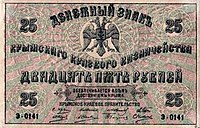Crimea in the five years after the Russian Revolution had a large number of governments culminating in being a stronghold of anti-Communist forces and the place on Russian soil where they made their last stand.
Following the Russian Revolution of 1917, the military and political situation in Crimea was chaotic like that in much of Russia. During the ensuing Russian Civil War, Crimea changed hands numerous times and was for a time a stronghold of the anti-Bolshevik White Army. It was in Crimea that the White Russians led by General Wrangel made their last stand against Nestor Makhno and the Red Army in 1920. When resistance was crushed, many of the anti-Bolshevik fighters and civilians escaped by ship to Istanbul.
Approximately 50,000 White prisoners of war and civilians were summarily executed by shooting or hanging after the defeat of General Wrangel at the end of 1920. This is considered one of the largest massacres in the Civil War.

Between 56,000 and 150,000 of the Whites were murdered as part of the Red Terror, organized by Béla Kun's Crimean Revolutionary Committee. The figures related to the massacre in Crimea remain contested. Anarchist and Bolshevik Victor Serge gave a lower figure for White officers around 13,000 which he claims were exaggerated. Yet, he condemned Kun for his treacherous actions towards allied anarchists and surrendering Whites.
According to social scientist, Nikolay Zayats, from the National Academy of Sciences of Belarus the large, “fantastic” estimates have derived from eyewitness accounts and White army emigre press. A Crimean Cheka report in 1921 showed that 441 people were shot with a modern estimation that 5,000-12,000 people in total were executed in Crimea.
Crimea changed hands several times over the course of the conflict and several political entities were set up on the peninsula. These included:
| Country | Jurisdiction | Period | Details |
|---|---|---|---|
| Russian Revolution and Civil War (1917–1921) | Crimean People's Republic | December 1917 – January 1918 | Crimean Tatar government |
| Taurida Soviet Socialist Republic | 19 March – 30 April 1918 | Bolshevik government | |
| Ukrainian State | May – June 1918 | ||
| First Crimean Regional Government | 25 June – 25 November 1918 | German puppet state under Lipka Tatar General Maciej (Suleyman) Sulkiewicz | |
| Second Crimean Regional Government | November 1918 – April 1919 | Anti-Bolshevik government under Crimean Karaite former Kadet member Solomon Krym | |
| Crimean Socialist Soviet Republic | 2 April – June 1919 | Bolshevik government | |
| South Russian Government | February – April 1920 | Government of White movement's General Anton Denikin | |
| Government of South Russia | April (officially, 16 August) – 16 November 1920 | Government of White movement's General Pyotr Wrangel | |
| Bolshevik revolutionary committee government | November 1920 – 18 October 1921 | Bolshevik government under Béla Kun (until 20 February 1921), then Mikhail Poliakov | |
| Crimean Autonomous Socialist Soviet Republic | 18 October 1921 – 30 June 1945 | Autonomous republic of the Russian SFSR | |
| Soviet era (1921–1991) |
References
- Gellately, Robert (2007). Lenin, Stalin, and Hitler: The Age of Social Catastrophe. Knopf. p. 72. ISBN 978-1-4000-4005-6.
- Nicolas Werth, Karel Bartosek, Jean-Louis Panne, Jean-Louis Margolin, Andrzej Paczkowski, Stephane Courtois, Black Book of Communism: Crimes, Terror, Repression, Harvard University Press, 1999, hardcover, page 100, ISBN 0-674-07608-7. Chapter 4: The Red Terror
- Pries, Ludger; Yankelevich, Pablo (28 October 2018). European and Latin American Social Scientists as Refugees, Émigrés and Return-Migrants. Springer. p. 60. ISBN 978-3-319-99265-5.
- Zayats, Nikolay. "On the scale of the Red Terror during the Civil War". scepsis.net.
This Crimea-related article is a stub. You can help Misplaced Pages by expanding it. |